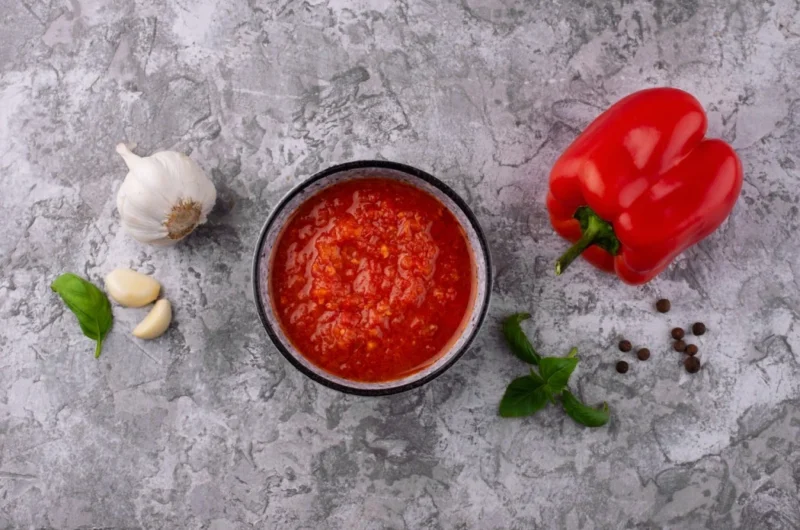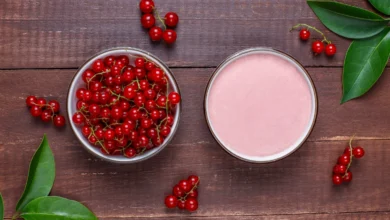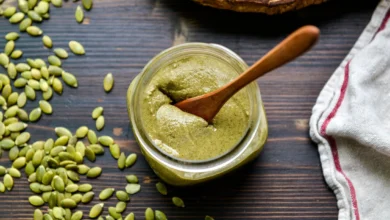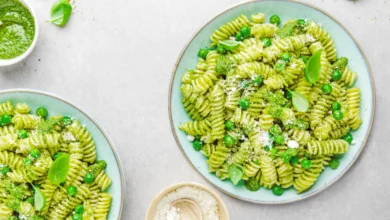Classic Italian Homemade Marinara Sauce Made from Scratch

Growing up, Sunday dinner was always a special occasion at my Nonna’s house. She would spend all day in the kitchen preparing her famous rustic and hearty marinara sauce. Known affectionately as Sunday Gravy, it was the soul of the meal. As the mouthwatering aromas filled the house, I would peek over Nonna’s shoulder, watching her patiently chop onions and tomatoes, handing her ingredients as she worked her magic.
“The secret is taking your time and letting the flavours develop naturally,” she would tell me. Those tomatoes packed with natural sugars would simmer for hours, melting into a thick and chunky sauce. At the end of the day, the kitchen was a mess, but the pot of Sunday Gravy was worth it. Every bite of her sauce, transporting me right back to Nonna’s, was so full of flavour I could have eaten it by the spoonful. To this day, that marinara remains my favourite part of a home-cooked Italian meal.
While Nonna’s sauce was an all-day affair, I’ve learned some shortcuts to get that rich, authentic marinara sauce flavour without as much fuss. A few anchovies browned in olive oil add depth without overpowering the tomatoes. A splash of wine is just enough to lift everything, but not make it booze-forward. And a generous spoonful of heavy cream brings a velvety texture without losing that classic rustic quality. This simple twist makes weeknight dinners feel just as special as Sundays at Nonna’s.
Contents
- Italian Homemade Marinara Sauce
- Italian Homemade Marinara Sauce
- Ingredients
- Directions
- Notes
- Recipe FAQs
- Can I use fresh tomatoes instead of canned to make marinara sauce?
- How do I know when homemade marinara sauce is ready?
- How do I store homemade marinara sauce?
- What is typically in marinara sauce?
- Do you need sugar in marinara sauce?
- What is the difference between marinara and spaghetti sauce?
- What are the best tomatoes to use in marinara sauce?
- What is classic marinara sauce made of?
- Is traditional Italian sauce the same as marinara?
- What is marinara sauce in Italy?
- What are the 5 Italian sauces for pasta?
Italian Homemade Marinara Sauce
These days, I also enjoy exploring vegan and pure vegetarian options for pasta. Reliable standbys like spaghetti and bucatini take well to sauces made solely from tomatoes, onion, basil, and garlic. But I’m also experimenting with produce-forward pastas like ricotta gnocchi tossed with a puréed sauce of vine-ripened tomatoes and charred eggplant. Squash-filled ravioli topped with a roasted red pepper coulis is simple yet feels indulgent. And a vegan lasagna made creamy with cashews never feels like it’s missing ricotta. Nonna would be proud of how far her lessons have taken me in the kitchen.
Why You’ll Love it
1- A Multipurpose Pantry Staple
This classic marinara sauce is such a great all-purpose recipe to have on hand. Whether you need a simple pasta sauce, delicious pizza sauce, or dipping sauce for Italian appetizers, this adaptable tomato sauce delivers. With few pantry ingredients like canned tomatoes, olive oil, and garlic, even weeknight dinners become something special.
2- Gentle Simmering for Maximum Flavor
The long, gentle simmer coaxes out intense flavor as the tomatoes break down into a rich, velvety puree. A touch of seasoning like red pepper flakes allows you to control the heat to your liking. And fresh basil stirred in at the end adds a bright, tasty note that keeps it from tasting too tart or too sweet. Prep is also minimal compared to longer-cooking ragus or meat sauces.
3- Make a Huge Batch for Freezing
For a huge batch to see you through, consider doubling or tripling this recipe. It divides beautifully into smaller containers for freezing. Then all that’s needed is a few minutes of reheating to transport yourself straight to Nonna’s kitchen. Whether served over spaghetti, gently simmered meatballs, or baked golden eggplant, this marinara enhances Italian comfort dishes beautifully.
4- Enjoy Homemade Sauce Anytime
Getting in the habit of making a big batch is also ideal for using up a bounty of canned tomatoes after a sauce-making session. Leftover sauce tucked in the freezer is like having a little piece of Italy on hand whenever cravings strike.
Ingredients
Yield: 31⁄2 cups, enough for 1 pound (0.45 kg) of pasta
- 128-ounce can whole San Marzano tomatoes, certified D.O.P. if possible
- 1⁄4cup extra-virgin olive oil
- 7 garlic cloves, peeled and slivered
- A small amount of dried whole Chiles or crumbled red pepper flakes can be added for a touch of heat.
- 1teaspoon kosher salt
- 1large fresh basil sprig, or 1⁄4 teaspoon dried oregano, more to taste
This marinara sauce comes together with just a handful of key ingredients. Canned entire San Marzano tomatoes are best, but any full peeled plum tomatoes will work in a pinch. Using extra-virgin olive oil, garlic, Chile, and herbs like basil or oregano infuses the sauce with big flavour. A little salt brings out the natural sweetness of the tomatoes.
Preparation
Step 1
Once the tomatoes are soft, use your hands to break them apart into a bowl to create a crushed texture. Add about 1 cup of the water from the can; swish it around to slosh out all the tomato juices and reserve.
Step 2
In a frying-pan or pot, heat the oil over medium-high heat until hot but not smoking, then add the garlic.
Step 3
Cook until the garlic is sizzling, then add the tomatoes and their juice, plus the tomato water , the chile or red pepper flakes, the oregano and the salt. Stir to combine.
Step 4
Bring to a simmer , then place the basil sprig stem-side up on the surface. Wilt for 30 seconds, then submerge. Let the sauce simmer for 35 to 40 minutes, stirring occasionally, until thickened. Taste and add more salt or oregano if needed, then discard the chile.
How to Thicken Marinara Sauce?
The marinara sauce will thicken as it cooks but if you want it extra thick like classic gravy, allow some of the water to evaporate. Continue stirring frequently over the lowest possible flame being very careful not to let it burn. The natural sugars in the tomatoes will caramelize slightly, further thickening the sauce to your liking. If it reduces too much, you can always add a splash of water and continue cooking until it reaches your desired consistency. Just keep a close eye and be prepared to stir constantly as it thickens.
4 Top Tips
For a rustic or smooth sauce – If you like some texture, leave the tomatoes chunky. Or for a velvety smooth sauce, purée about half the tomatoes with a handheld immersion blender before adding back to the pot.
When adding a splash of wine – A splash of dry red wine added along with the tomatoes adds complex flavor that balances the acidity. It creates a rich, Italian-inspired marinara sauce recipe with wine.
When freezing extra batches – Portion individual servings into freezer bags or containers, lay flat to freeze, then stack once firm. This prevents soupiness caused by freezing in one large block.
Adjust seasoning before serving – Allow the sauce to sit overnight in the fridge then reheat gently, tasting to see if any final adjustments are needed. A pinch each of salt, pepper, or sugar can enhance the naturally developed flavours.
Ways to Use the Sauce
- Stuff and bake big pasta shells (conchiglione) with ricotta and spinach then cover with bubbling marinara.
- Layer slices of eggplant, tomato sauce and fresh mozzarella for a quick Greek moussaka.
- Simmer small meatballs in your favorite chunky sauce along with spaghetti for a classic Sunday dinner.
- Fry lightly breaded chicken cutlets or panko chicken pieces then top with sauce and melted cheese for chicken parmigiana.
- For a faster weeknight option, toss mushrooms, zucchini fries or air-fryer vegetables in sauce for a tasty side.
- Use as the base for homemade pizza or heat and dip cheese sticks, puff pastry twists or feta cheese pies.
- Serve the sauce generously over pasta for an authentic Sicilian marinara sauce recipe.
Nutrition
| Nutrient | Amount |
| Calories | 753kcal |
| Carbohydrates | 152g |
| Protein | 34g |
| Fat | 15g |
| Saturated Fat | 2g |
| Polyunsaturated Fat | 3g |
| Monounsaturated Fat | 8g |
| Cholesterol | 0.1mg |
| Sodium | 2727mg |
| Potassium | 6055mg |
| Fiber | 39g |
| Sugar | 91g |
| Vitamin A | 4504IU |
| Vitamin C | 191mg |
| Calcium | 712mg |
| Iron | 27mg |
This classic marinara sauce is packed with nutrients from the fresh tomatoes and herbs. It provides a hearty dose of vitamins A and C as well as potassium , fiber and lycopene. While higher in sodium, the natural sugars help balance the flavour profile. Use it generously to turn everyday pasta meals into nutritional powerhouses.
Italian Homemade Marinara Sauce
Course: SauceCuisine: Italian6
servings10
minutes40
minutes753
kcal50
minutesHere is the recipe ingredients, and instructions. You can also print the recipe for your ease.
Ingredients
28oz can whole peeled tomatoes
1⁄4 cup olive oil
7 garlic cloves
Dried chilies or crushed red pepper, optional for desired spice level
1 tsp salt
Fresh basil
Directions
- Crush tomatoes into a bowl.
- Sauté garlic in oil in a pot until fragrant.
- Add tomatoes, chiles, salt and basil.
- Simmer for 30-40 minutes, until thickened.
- Adjust seasoning to taste.
Notes
- A classic Italian pasta sauce with bright flavors.
- Gently simmer tomatoes to develop rich flavor.
- Freeze extras in portions for quick meals.
- Use within 5 days refrigerated or freeze up to 3 months.
- Also delicious on pizza, meatballs, veggies.
Conclusion
In conclusion, this recipe captures the essence of classic Italian marinara sauce, allowing the bright flavours of fresh tomatoes, garlic, and herbs to shine through with a simple procedure. Homemade sauce can be enjoyed immediately or stored and frozen for later use, providing an authentic Italian flavor for favorites like pasta, pizza and more. With tips provided, anyone can make their own tasty marinara at home.
To read more about Pasta, Drinks and some delightful recipes, check the rest of our blog.
Recipe FAQs
Can I use fresh tomatoes instead of canned to make marinara sauce?
Yes, fresh tomatoes can be used instead of canned. Look for ripe, juicy tomatoes of the San Marzano variety if possible. Blanch and peel them before chopping and using in the recipe like canned tomatoes. A homemade marinara sauce made from fresh tomatoes will have a brighter, fresher flavor.
How do I know when homemade marinara sauce is ready?
Some clues that the homemade marinara sauce is ready include its color becoming deeper and darker red as it cooks, the sauce thickening slightly as the watery liquid reduces, and a thicker, richer texture compared to when it was more watery. Ultimately, it comes down to personal preference on timing for simmering.
How do I store homemade marinara sauce?
For storage, the classic way is to cool the marinara completely then transfer it to airtight containers. It will keep in the fridge for 4-5 days or can be frozen in portions for months. Thaw overnight in the fridge or reheat gently on the stovetop or microwave until hot throughout.
What is typically in marinara sauce?
The base ingredients in traditional marinara sauce include tomatoes, onions, garlic and Italian seasonings like basil, oregano and sometimes mint. Red pepper flakes, salt and black pepper are also common. Meat sauces may contain ground meat, while vegetarian versions use vegetables instead. Cheese is sometimes mixed in at the end or served on top.
Do you need sugar in marinara sauce?
A small pinch of sugar can help balance the natural acidity of the tomatoes for a well-rounded flavor. It’s optional but may make the sauce taste slightly mellower and less sharp.
What is the difference between marinara and spaghetti sauce?
The main difference is cooking time – marinara sauce is simmered for a shorter period, resulting in a brighter, more vibrant red color and fresher tomato taste. Spaghetti sauce is simmered for hours until darker and thicker with a deeper, richer depth of flavor. Meat sauces are long-simmered tomato sauces that contain meat, which adds greatly to the overall flavor profile.
What are the best tomatoes to use in marinara sauce?
The best tomatoes for homemade marinara sauce are San Marzano tomatoes from Italy’s San Marzano Region near Mount Vesuvius. They have a plum shape, thinner skin and longer shelf life that allows rich, intense flavor to develop during cooking.
What is classic marinara sauce made of?
Classic marinara sauce is made by heating oil in a medium heavy pot over medium heat. Onion and garlic are added to the hot oil and cooked for a few minutes, stirring occasionally, until the onion is soft. Tomatoes and basil are then added along with salt and pepper. The tomatoes are cooked for about 10-15 minutes, stirring occasionally, until very soft. At this point, the tomatoes are crushed by hand to fully puree them. More basil may be stirred in before increasing the heat to bring the sauce to a gentle simmer. Seasoning is adjusted as needed during the 20-30 minutes of simmering.
Is traditional Italian sauce the same as marinara?
While both are tomato-forward, traditional Italian Sunday gravy or ragu is thicker and creamier, almost like a hearty meat gravy. Marinara is brighter in color, thinner in consistency and more tomato forward in flavor profile.
What is marinara sauce in Italy?
In Italian cuisine, “alla marinara” refers to tomato sauces made simply with tomatoes, olive oil, garlic, oregano and sometimes basil or olives/capers. It’s traditionally served with pasta like spaghetti or vermicelli, but can also accompany fish or meat.
What are the 5 Italian sauces for pasta?
- Ragù alla Bolognese.
- Cacio e Pepe.
- Salsa di Pomodoro.
- Sugo alla Norma.
- Sugo all’Arrabbiata





